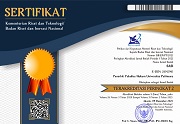The Participation of Indigenous Peoples in the Development of Geographical Indications: Between Orientation and Formulation
 ), Muhammad Akbar(2), Samsuria Samsuria(3), Ida Lestiawati(4)
), Muhammad Akbar(2), Samsuria Samsuria(3), Ida Lestiawati(4)
(1) Faculty of Law Muhammadiyah Palu University, Palu, Indonesia
(2) Datokarama State Islamic University, Palu, Indonesia
(3) Faculty of Law Muhammadiyah Palu University, Palu
(4) Faculty of Law Muhammadiyah Palu University, Palu, Indonesia
 Corresponding Author
Corresponding Author
Abstract
Introduction: Characteristics of Indigenous Peoples in managing this natural potential has relevance to optimizing the potential of geographical indications. Even so, legal problems occur when in positive law in Indonesia there is no regulation regarding the participation and role of the Customary Law Community in optimizing geographical indications.
Purpose of The Research: This research aims to regulatory orientation and formulation regarding the participation of Indigenous Peoples in optimizing the potential of geographical indications.
Methods of Research: This research is a normative legal research with a concept and statutory approach. The analysis is carried out by carrying out an inventory of legal materials, then proceed with the reduction process (sorting) according to the needs in the selection, and ends with conclusions.
Results of the Research: The participation of the Indigenous Peoples in optimizing the potential of geographic indications can actually be carried out by involving the role of both the central and regional governments to facilitate it. Appropriate formulations related to arrangements regarding the participation of Indigenous Peoples in optimizing the potential of geographical indications can be carried out by forming cooperatives or associations of producers related to geographical indications. This needs to be done because in the provisions of positive law, Indigenous Peoples are not one of the parties that can become applicants for registration of geographical indications. Revisions to regulations regarding geographical indications need to be made in order to optimize the role and participation of the Indigenous Peoples.
Keywords
DOI
10.47268/sasi.v29i3.1505
Published
2023-06-12
How To Cite
@article{SASI1505,
author = {Maisa Maisa and Muhammad Akbar and Samsuria Samsuria and Ida Lestiawati},
title = {The Participation of Indigenous Peoples in the Development of Geographical Indications: Between Orientation and Formulation},
journal = {SASI},
volume = {29},
number = {3},
year = {2023},
keywords = {Geographical Indications; Intellectual Property; Indigenous Peoples.},
abstract = {Introduction: Characteristics of Indigenous Peoples in managing this natural potential has relevance to optimizing the potential of geographical indications. Even so, legal problems occur when in positive law in Indonesia there is no regulation regarding the participation and role of the Customary Law Community in optimizing geographical indications.Purpose of The Research: This research aims to regulatory orientation and formulation regarding the participation of Indigenous Peoples in optimizing the potential of geographical indications.Methods of Research: This research is a normative legal research with a concept and statutory approach. The analysis is carried out by carrying out an inventory of legal materials, then proceed with the reduction process (sorting) according to the needs in the selection, and ends with conclusions.Results of the Research: The participation of the Indigenous Peoples in optimizing the potential of geographic indications can actually be carried out by involving the role of both the central and regional governments to facilitate it. Appropriate formulations related to arrangements regarding the participation of Indigenous Peoples in optimizing the potential of geographical indications can be carried out by forming cooperatives or associations of producers related to geographical indications. This needs to be done because in the provisions of positive law, Indigenous Peoples are not one of the parties that can become applicants for registration of geographical indications. Revisions to regulations regarding geographical indications need to be made in order to optimize the role and participation of the Indigenous Peoples.},
issn = {2614-2961}, pages = {524--534} doi = {10.47268/sasi.v29i3.1505},
url = {https://fhukum.unpatti.ac.id/jurnal/sasi/article/view/1505}
}
Journal Article
Adhi, Yuli Prasetyo, Dewi Sulistianingsih, and Rini Fidiyani. “Pengelolaan Kekayaan Intelektual Berbasis Kearifan Lokal Sebagai Penguatan Budaya Literasi, Kreativitas, Dan Inovasi.” Jurnal Pengabdian Hukum Indonesia 04, no. 1 (2021): 18–30.
Adi Suliantoro, Fitika Andraini, Arikha Saputra. “Potensi Dan Kendala Pendaftaran Indikasi Geografis Kota Semarang.” Komunikasi Hukum 9, no. 1 (2023): 1569–88. https://doi.org/10.35295/OSLS.IISL/0000-0000-0000-1275.
Asher, Rachael. “Unresolved Injustice : An Examination of Indigenous Legal Issues in Australia.” Udayana Journal of Law and Culture 4, no. 2 (2020): 146–70.
Asteria, Donna, Agus Brotosusilo, M. R. Soedrajad, and F. N. Nugraha. “Adat Law and Culture: The Local Authority Elements of Baduy Tribe on Environment Preservation.” IOP Conference Series: Earth and Environmental Science 716, no. 1 (2021). https://doi.org/10.1088/1755-1315/716/1/012049.
Balqis Siagian, Saidin, Suhaidi, Sunarmi. “Pelindungan Hukum Atas Potensi Indikasi Geografis Di Kabupaten Tapanuli Utara.” Iuris Studia 2, no. 8 (2021): 655.
Boor, Catharina van der, Carlos Iván Molina-Bulla, Anna Chiumento, and Ross G. White. “Application of the Capability Approach to Indigenous People’s Health and Well-Being: Protocol for a Mixed-Methods Scoping Review.” BMJ Open 12, no. 12 (2022): e066738. https://doi.org/10.1136/bmjopen-2022-066738.
Darwance, Darwance, Yokotani Yokotani, and Wenni Anggita. “Politik Hukum Kewenangan Pemerintah Daerah Dalam Pengaturan Hak Kekayaan Intelektual.” Journal of Political Issues 2, no. 2 (2021): 124–34. https://doi.org/10.33019/jpi.v2i2.40.
Deslaely Putranti, Dewi Analis Indriyani. “Perlindungan Indikasi Geografis Oleh Masyarakat Perlindungan Indikasi Geografis Pasca Sertifikasi Di Yogyakarta.” Ilmiah Kebijakan Hukum 15, no. 3 (2021): 397.
Disantara, Fradhana Putra. “Konsep Pluralisme Hukum Khas Indonesia Sebagai Strategi Menghadapi Era Modernisasi Hukum.” Al-Adalah: Jurnal Hukum Dan Politik Islam 6, no. 1 (January 1, 2021): 1–36. https://doi.org/10.35673/ajmpi.v6i1.1129.
Flambonita, Suci. “The Concept of Legal Pluralism in Indonesia in the New Social Movement.” Jurnal Analisa Sosiologi 10, no. 3 (2021): 361–73. https://doi.org/10.20961/jas.v10i0.45939.
Han, Feifei. “Sustainable Teaching Strategies to Teach Indigenous Students: Their Relations to Students’ Engaged Learning and Teachers’ Self-Concept.” Sustainability (Switzerland) 14, no. 17 (2022). https://doi.org/10.3390/su141710973.
Khadka, Jiban, Krishna Prasad Adhikari, and Niroj Dahal. “The Learning Performance of Indigenous Students in Nepali Private Schools: A Mixed-Methods Study.” International Journal of Instruction 15, no. 4 (2022): 987–1010. https://doi.org/10.29333/iji.2022.15453a.
Kurniawan, I Gede Agus, Lourenco de Deus Mau Lulo, and Fradhana Putra Disantara. “IUS Constituendum of Expert Advisor in Commodity Futures Trading: A Legal Certainty.” Jurnal IUS Kajian Hukum Dan Keadilan 11, no. 1 (2023): 31–45. https://doi.org/https://doi.org/10.29303/ius.v11i1.1170.
Labetubun, Muchtar Anshary Hamid, Rory Jeff Akyuwen, and Theresia Nolda Agnes Narwadan. “Workshop Kekayaan Intelektual Sebagai Upaya Peningkatan Pemahaman Dalam Rangka Pengenalan Dan Perlindungan Indikasi Geografis Minyak Kayu Putih Namlea Pulau Buru.” Aiwadthu: Jurnal Pengabdian Hukum 1, no. 2 (2021): 94. https://doi.org/10.47268/aiwadthu.v1i2.671.
Mahila, Syarifa. “Problematika Perlindungan Hukum Terhadap Produk Indikasi Geografis.” Jurnal Ilmiah Universitas Batanghari Jambi 19, no. 3 (2019): 639. https://doi.org/10.33087/jiubj.v19i3.769.
Negara, Tunggul Ansari Setia. “Normative Legal Research In Indonesia: Its Origins And Approaches.” ACLJ 4, no. 1 (2023): 5.
Nova, Sri Asih Roza. “Perlindungan Hukum Terhadap Pengetahuan Tradisional Di Indonesia Dari Tindakan Misappropriation.” Swara Justisia 6, no. 4 (2023): 433–43. https://doi.org/10.32502/khdk.v4i1.4488.
Nugroho, Wahyu. “Relationship between Environmental Management Policy and the Local Wisdom of Indigenous Peoples in the Handling of Covid-19 in Indonesia.” Onati Socio-Legal Series 11, no. 3 (2021): 860–82. https://doi.org/10.35295/OSLS.IISL/0000-0000-0000-1193.
Pawana, Sekhar Chandra, and Erico L Hutahuruk. “Optimaliasasi Pemajuan Kebudayaan Daerah Melalui Indikasi Geografis.” Justicia Sains: Jurnal Ilmu Hukum 6, no. 2 (2022): 228–47. https://doi.org/10.24967/jcs.v6i2.1584.
Prasetio, Dicky Eko, Fradhana Putra Disantara, Nadia Husna Azzahra, and Dita Perwitasari. “The Legal Pluralism Strategy of Sendi Traditional Court in the Era of Modernization Law.” Rechtsidee 8 (March 9, 2021): 1–14. https://doi.org/10.21070/jihr.2021.8.702.
Putri, Karina, Sartika Intaning Pradhani, and Hendry Julian Noor. “The Existence of Adat Law Community in Public-Private Partnership.” Yustisia Jurnal Hukum 9, no. 3 (2020): 306. https://doi.org/10.20961/yustisia.v9i3.25492.
Rachman, A H. “Ketidakpastian Status Lahan Dan Potensi Deforestasi Dalam Wacana Pembangunan Bandar Antariksa Biak.” Jentera: Jurnal Hukum 4, no. 1 (2021): 394.
Rian Saputra, Pujiyono, Sunny Ummul Firdaus. “Un Synchronized Registration Regulation Of Geographic Indications In Indonesia On Products Traditional Alcoholic Drink.” Journal of Legal, Ethical and Regulatory Issues 25, no. 4 (2022): 1–13.
Rudy, R., Y. Yonariza, Helvi Yanfika, Ali Rahmat, Winih Sekaringtyas Ramadhani, and Dan Abdul Mutolib. “Forest Cover Change and Legal Pluralism in Forest Management: A Review and Evidence from West Sumatra, Indonesia.” Indonesian Journal of Science and Technology 6, no. 2 (2021): 299–314. https://doi.org/10.17509/ijost.v6i2.34190.
Sinaga, Niru Anita. “Pentingnya Perlindungan Hukum Kekayaan Intelektual Bagi Pembangunan Ekonomi Indonesia.” Jurnal Hukum Sasana 6, no. 2 (2020): 144–65. https://doi.org/10.31599/sasana.v6i2.385.
Souza Meirelles, Franklin de, Janaina de Moura Engracia Giraldi, and Rodolfo Paião de Campos. “Transaction Costs Economics and Geographical Indications: A Systematic Analysis of the Literature.” Revista de Economia e Sociologia Rural 61, no. 4 (2023): 1–22. https://doi.org/10.1590/1806-9479.2022.264494.
Tehupeiory, Aartje, and Lamhot Naibaho. “Enhancing Community Legal Awareness of Land Right Disputes through the Use of Legal Aid Institutions.” International Journal of Psychosocial Rehabilitation 24, no. 8 (2020): 1223–31. https://doi.org/10.37200/IJPR/V24I8/PR280136.
Tiaraputri, A., L. Diana, and E. Deliana. “Could Kuansing’s Pangasius Kunyit Be Protected by Geographical Indication?” IOP Conference Series: Earth and Environmental Science 1118, no. 1 (2022). https://doi.org/10.1088/1755-1315/1118/1/012081.
Trihartono, Agus, and Suyatno Ladiqi. “Extending Indonesian Gastrodiplomacy:Blending Geographical Indication (Gi) and "Kopi Indonesia".” Iium Law Journal 30 (2022): 35–48.
Zurba, Melanie, and Anastasia Papadopoulos. “Indigenous Participation and the Incorporation of Indigenous Knowledge and Perspectives in Global Environmental Governance Forums: A Systematic Review.” Environmental Management 2030, no. 1 (2021): 5. https://doi.org/10.1007/s00267-021-01566-8.
Book
Diantha, I Made Pasek. Metodologi Penelitian Hukum Normatif. Cetakan ke. Jakarta: Prenadamedia Group, 2017.
Eka N.A.M. Sihombing, Cynthia Hadita. Penelitian Hukum. 1st ed. Malang: Setara Press, 2022.
| Dublin Core | PKP Metadata Items | Metadata for this Document | |
| 1. | Title | Title of document | The Participation of Indigenous Peoples in the Development of Geographical Indications: Between Orientation and Formulation |
| 2. | Creator | Author's name, affiliation, country | Maisa Maisa; Faculty of Law Muhammadiyah Palu University, Palu; Indonesia |
| 2. | Creator | Author's name, affiliation, country | Muhammad Akbar; Datokarama State Islamic University, Palu; Indonesia |
| 2. | Creator | Author's name, affiliation, country | Samsuria Samsuria; Faculty of Law Muhammadiyah Palu University, Palu |
| 2. | Creator | Author's name, affiliation, country | Ida Lestiawati; Faculty of Law Muhammadiyah Palu University, Palu; Indonesia |
| 3. | Subject | Discipline(s) | |
| 3. | Subject | Keyword(s) | Geographical Indications; Intellectual Property; Indigenous Peoples. |
| 4. | Description | Abstract | Introduction: Characteristics of Indigenous Peoples in managing this natural potential has relevance to optimizing the potential of geographical indications. Even so, legal problems occur when in positive law in Indonesia there is no regulation regarding the participation and role of the Customary Law Community in optimizing geographical indications.Purpose of The Research: This research aims to regulatory orientation and formulation regarding the participation of Indigenous Peoples in optimizing the potential of geographical indications.Methods of Research: This research is a normative legal research with a concept and statutory approach. The analysis is carried out by carrying out an inventory of legal materials, then proceed with the reduction process (sorting) according to the needs in the selection, and ends with conclusions.Results of the Research: The participation of the Indigenous Peoples in optimizing the potential of geographic indications can actually be carried out by involving the role of both the central and regional governments to facilitate it. Appropriate formulations related to arrangements regarding the participation of Indigenous Peoples in optimizing the potential of geographical indications can be carried out by forming cooperatives or associations of producers related to geographical indications. This needs to be done because in the provisions of positive law, Indigenous Peoples are not one of the parties that can become applicants for registration of geographical indications. Revisions to regulations regarding geographical indications need to be made in order to optimize the role and participation of the Indigenous Peoples. |
| 5. | Publisher | Organizing agency, location | Faculty of Law, Universitas Pattimura |
| 6. | Contributor | Sponsor(s) | Faculty of Law Muhammadiyah Palu University, Palu; Datokarama State Islamic University, Palu |
| 7. | Date | (YYYY-MM-DD) | 2023-06-12 |
| 8. | Type | Status & genre | Peer-reviewed Article |
| 8. | Type | Type | |
| 9. | Format | File format | |
| 10. | Identifier | Uniform Resource Identifier | https://fhukum.unpatti.ac.id/jurnal/sasi/article/view/1505 |
| 10. | Identifier | Digital Object Identifier | 10.47268/sasi.v29i3.1505 |
| 11. | Source | Title; vol., no. (year) | SASI; Volume 29 Issue 3, September 2023 |
| 12. | Language | English=en | en |
| 13. | Relation | Supp. Files |
Hasil Cek Plagiasi (3MB) |
| 14. | Coverage | Geo-spatial location, chronological period, research sample (gender, age, etc.) | |
| 15. | Rights | Copyright and permissions | Copyright: Authors who publish their manuscripts in this Journal agree to the following conditions: 1. The copyright in each article belongs to the author, as well as the right to patent. 2. Authors can enter into separate, additional contractual arrangements for the non-exclusive distribution of the journal's published version of the work (e.g., post it to an institutional repository or publish it in a book), with an acknowledgment of its initial publication in this journal. 3. Authors are permitted and encouraged to post their work online (e.g., in institutional repositories or on their website) before and during the submission process, as it can lead to productive exchanges, as well as earlier and greater citation of published work. 4. Authors have the right to self-archiving of the article (Author Self-Archiving Policy)
License: The SASI Journal is disseminated based on the Creative Commons Attribution-NonCommercial 4.0 International license terms. This license allows anyone to copy and redistribute this material in any form or format, compose, modify, and make derivatives of this material for any purpose. You cannot use this material for commercial purposes. You must specify an appropriate name, include a link to the license, and certify that any changes have been made. You can do this in a way that is appropriate but does not imply that the licensor supports you or your use.
|
Copyright (c) 2023 Maisa Maisa, Muhammad Akbar, Samsuria Samsuria, Ida Lestiawati

This work is licensed under a Creative Commons Attribution-NonCommercial 4.0 International License.

 : 2200 times
: 2200 times Download : 1062 times
Download : 1062 times
















